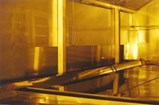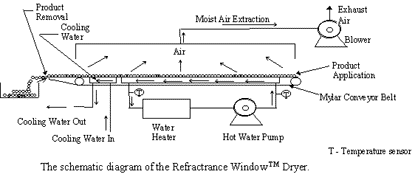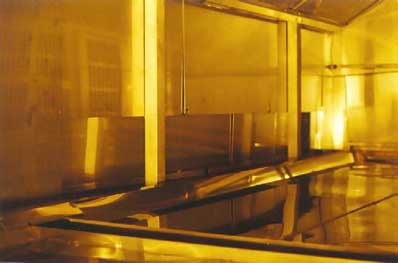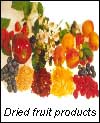Refractance Window food drying system delivers quality product efficiently

By Karin M. Bolland, M.A. Ed., MCD Technologies, Inc.
The following article details a new drying process using Refractance Window technology, developed by Richard Magoon of MCD Technologies. Tests on Refractance Window drying equipment have shown superior levels of nutrient retention, color, flavor, and aroma as compared to conventional drying methods like freeze drying, spray drying and drum drying. Refractance Window drying equipment performs continuous drying in 2-6 minutes and utilizes far less energy than comparable drying methods.
Background of Commercial Dehydration
Drying is man's oldest preservation method. Drying reduces moisture content and lowers water activity in perishable products to safe levels, thereby prolonging shelf life and adding value. Compared to products produced with other preservation methods, dehydrated products have almost unlimited shelf-life and substantially lower transportation, handling and storage costs. In the United States, they provide opportunities for maximum convenience, flexibility, and economics as industrial and food service ingredients, whereas in other countries they are also frequently consumer products, as well.
Although several commercial drying methods have been developed over time, none have previously been able to provide high quality yet economical products.
Sun drying and hot air drying cause significant loss of color that make the product less appealing to consumers and can result in losses of nutrient content and rehydration ability.
Drum drying, developed for liquid products, causes severe quality loss in product due to exposure to high temperatures (120-170°C). The drums may be enclosed in a vacuum chamber to reduce drying temperatures, but the capital cost limits the use of this technique to only special applications.
Spray drying is often used for liquid foods with major limitations of high capital costs and the requirement for a relatively high feed moisture content to ensure that the feed can be pumped to the atomizer. Spray dried products often suffer from high volatile losses due to atomization and high air temperature of 150-300°C (although the temperature of most particles may remain at the wet bulb temperature of the air), as well as significant nutrient losses. High shear action during the atomization may also make this technique unsuitable for products that are sensitive to mechanical damage.
Freeze drying is a commercial process that can produce high quality dehydrated products with good retention of shape, flavor, color, nutrient content, and rehydration ability. The cost of producing freeze-dried product is very high, up to ten times the cost for using forced hot air drying.
A New, Low Temperature, Energy Efficient Drying Process
Refractance Window Technology is a new drying system, invented and developed by Richard Magoon, owner of MCD Technologies, Inc. of Tacoma, Washington. Refractance Window drying uses circulating water at atmospheric pressure to carry heat to the product to be dried. Moist product is applied to the upper surface of an infrared-transparent, plastic conveyer belt that floats on the surface of the heated, circulating water. This water is continuously re-circulated and re-heated, so as to maintain temperature as heat energy is transferred to the product.

Unlike hot air tray or tunnel dryers that require several hours or freeze dryers that take from 12 to 72 hours, Refractance Window dryers require only 2 to 6 minutes to dry most products. Refractance Window drying has major advantages over tray and tunnel drying, as well as over drum drying and spray drying, in that foods and pharmaceutical ingredients are exposed to much milder temperatures and final products maintain high levels of sensory qualities, such as color, flavor, and aroma.
Refractance Window drying uses a low-temperature/short-time continuous process to dry delicate, heat-sensitive products such as fruit and vegetable purees. Drying takes place at atmospheric pressure to retain product color, flavor, aroma and nutritional content. Product quality is comparable to and, in some instances, better than that achieved by freeze-drying. This is done at significantly less capital and energy cost. One dramatic example: The patented process dries raspberry puree from 92% moisture to 2-4% moisture in just five minutes. The rapid, gentle drying minimizes product degradation caused by heat and oxidation and maximizes retention of color, flavor, and aroma. No sulfites or other additives are needed. Dried product has high bulk density.
The Self-Limiting Infrared 'Window'
The term "Refractance Window" relates to the dryer's principle of operation. Water transmits heat energy within itself by all three heat transfer methods: conduction, convection and radiation. Of these, radiation is the most rapid, taking place at nearly the speed of light. If the water's surface is covered by a transparent medium such as plastic, evaporation and its associated heat loss is blocked and only conduction occurs. But when a moisture-laden product is placed on the plastic surface, a "window" for passage of infrared energy is created at the point where the moist product contacts the plastic and the plastic bears on the water. At this point all three methods of heat transfer, radiation, conduction and convection, occur for exceptionally effective heat transfer into the product, producing rapid evaporation. As the product dries, however, the infrared "window" closes, effectively limiting heat transfer to the product to conduction. Since plastic is a poor heat conductor, the product is protected from overheating. In effect, a self-limiting drying process is built into the system, a system that is less dependent on operator intervention for maintenance of quality characteristics in products to be dried. It is a system where water transmits heat energy into the product, forcing product moisture to evaporate. In other words, the process uses water to evaporate water.

Inside drying chamber
Drying Parameters
Refractance Window dryers dry most products with circulating water temperatures  from 200 to 210°F. Due to evaporative cooling, product temperatures remain between 135 and 160°F. When operating with circulating water at lower temperatures, drying time increases, but even with circulating water temperature at 100°F, pharmaceutical and bioactive preparations can be efficiently dried. Free moisture evaporates by the time the product reaches the midpoint of the dryer. Dried product is discharged in flake, sheet or small particle form at the product removal end of the dryer, where it is broken up, if necessary, and bagged.
from 200 to 210°F. Due to evaporative cooling, product temperatures remain between 135 and 160°F. When operating with circulating water at lower temperatures, drying time increases, but even with circulating water temperature at 100°F, pharmaceutical and bioactive preparations can be efficiently dried. Free moisture evaporates by the time the product reaches the midpoint of the dryer. Dried product is discharged in flake, sheet or small particle form at the product removal end of the dryer, where it is broken up, if necessary, and bagged.
Product Applications for Refractance Window Drying
To date Refractance Window drying has been successfully employed to test dry a wide variety of products:
- Fruits and Vegetables - single strength and concentrated purees, juices, pulps, chunky purees including purees with seeds, and fruit and vegetable by-products
- Meat, Fish, and Poultry - purees and broths
- Dairy and Egg products, including dairy cultures
- Cereals, Grains, and Starches
- Flavors and Colors
- Beverages - concentrates and mixes
- Nutraceuticals
- Pharmaceuticals
- Fine Chemicals
While products from many of the above listed product categories have been done on a test basis, commercial applications of the technology are increasing. Clermont of Hillsboro, Oregon, pioneered the commercial use of MCD's Refractance Window dryers in 1992 by drying their fruit purees and juices. Today there are commercial Refractance Window dryers helping companies dry a variety of different products from brine shrimp and micro-algae to herbal extracts and dairy by-products.
Additionally, MCD Technologies recently installed a dryer in their Tacoma, Washington, facility. There they will provide full-scale throughput testing and market samples for dryer customers, in addition to contract drying services to customers with limited drying requirements.
For more information contact MCD Technologies, Inc., 2515 South Tacoma Way, Tacoma, WA 98409. Tel: 253-476-0968; Fax: 253-476-0974.
